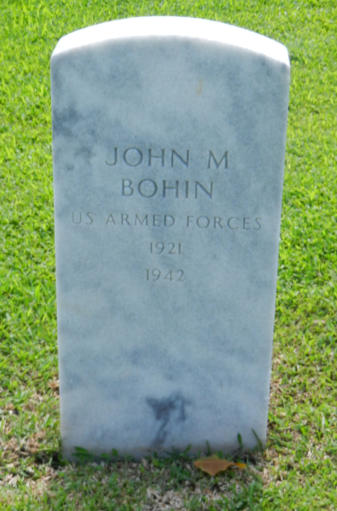
copyright © Wartime Heritage Association
Website hosting courtesy of Register.com - a web.com company
Wartime Heritage
ASSOCIATION
Remembering World War II
Name:
Martin John Bohin
Rank:
Seaman Second Class
Service No:
6071575
Service:
USS John W. Brown, US Navy
Date of Birth:
November 29, 1920
Place of Birth:
New Glasgow, Pictou Co., NS
Date of Enlistment:
July 16, 1942
Place of Enlistment:
Boston, Massachusetts
Address at Enlistment:
88 Webster Ave, Cambridge, Middlesex Co., Massachusetts
Age at Enlistment:
21
Height:
5 feet, 7 ½ inches
Complexion:
Light
Eye Color:
Blue
Hair Color:
Brown
Occupation:
Boston & Albany Railroad Co.
Religion:
Catholic
Next of Kin:
Rose Bonin (Mother), Cambridge, Mass.
Date of Death:
October 24, 1942
Cemetery:
Corozal American Cemetery and Memorial, Panama
Grave Reference:
Plot D Row 9 Grave 10
Seaman Second Class Martin John Bohin was the son of Joseph Willard Bonin (1886-1966) and Rose
Jane (Benoit) Bonin (circa 1890-1959). His parents were born in Pomquet, Antigonish Co., NS. His
father was employed as a brakeman and trainman with the CNR (Canadian National Railway). Martin’s
birth certificate records his surname as Bonin.
Martin’s siblings included Anna Jane Bonin (1911-1988) and Joseph Willard Bonin Jr (1912-1964), born
in Boston, Mass., George Arthur Bonin (1914-1980), and Rita M. (Bonin) Cone (1919-2010), born in
Nova Scotia, and Doris Esther (Bonin) Haldoupis (1924-1976), born in Somerville, Mass.
Martin’s sister Rita’s husband, Charles Francis Cone (1914–1965), served in the U.S. Coast Guard
during WWII, holding the rank of Boatswain's Mate Chief Petty Officer (BTC), Service No. 202336. He
served from July 15, 1936, to October 1, 1956. Martin’s sister Doris’s husband, Peter Constantine
Haldoupis (1918–1964), also served during the war. He was a Sergeant in the U.S. Army, Service No.
31029440, assigned to the 101st Ordnance Company from March 13, 1941, until August 19, 1945.
Martin registered for the US Draft on February 16, 1942, in Cambridge, Middlesex Co., Mass. At the
time he was working for the Boston & Albany Railroad Company. After enlisting in July of 1942 with
the US Naval Reserve, his rating was changed to Boatswain's Mate 2nd Class (BM2c) on September 16,
1942. On September 24, 1942, he joined the Naval Armed Guard Center in South Brooklyn, New York.
He served as a Seaman Second Class (S2c) aboard the Liberty Ship USS John W. Brown during its
maiden voyage to the Persian Gulf during World War II.
The declassified Armed Guard Log of the SS John Brown records the cause of Martin’s death. A bunk
mate accidently shot him with a pistol he thought was unloaded. Martin was the only casualty aboard
the SS John Brown which completed its subsequent missions without the loss of life of any of its crew.
Seaman Second Class Bohin was buried at the Mount Hope Cemetery (Cementerio Monte Esperanza) in
Colón, Panama and was reinterred at the Corozal American Cemetery near Panama City in 1979.
The SS John W. Brown is one of only two Liberty ships still in operation today, and one of just three
preserved as museum ships. Originally built as part of the United States Merchant Marine fleet during
World War II, she served as a merchant vessel before spending many years as a vocational training ship
for high school students in New York City. Her construction began on July 28, 1942, and she was
launched just weeks later on Labor Day, September 7, at the Bethlehem-Fairfield Shipyard in
Baltimore, Maryland. Named in honor of John W. Brown, a Maine labor leader who died in 1941, the
ship was part of a fleet of Liberty ships designed to be inexpensive and rapidly produced cargo
steamers. These vessels became the backbone of a vast wartime supply chain, transporting troops,
weapons, equipment, and essential goods to every theater of war. Remarkably, two-thirds of all cargo
shipped from the USA during the conflict traveled aboard Liberty ships. Though approximately 200
were lost to enemy attacks or maritime accidents, including collisions, groundings, and fires, the
sheer number of Liberty ships ensured that the sea
lanes remained open and vital supplies continued
to reach their destinations.
Martin John Bohin


Sources:
findagrave
US Battle Monuments Commission
SS John Brown
background photo: Corozal American Cemetery, Panama




- World War I - Menu
- WWI Stories and Articles
- Photos - Yarmouth Soldiers
- Selection of World War I Songs
- WWI Casualties of Yarmouth, NS
- Those Who Served - Yarmouth, NS
- WWI Casualties Digby Co. NS
- WWI Casualties Shelburne Co. NS
- Merchant Mariners (1915) Yarmouth, NS
- Canadian Forestry Corps - Non Yarmouth Birth/Residence Enlistments
- US Draft Registry - Yarmouth NS Born


- World War II - Menu
- WWII Stories and Articles
- Telegraphist Air Gunners
- WWII Casualties of Nova Scotia
- US Casualties with NS Connection
- Far East/Pacific Casualties with NS Connection
- Merchant Navy Casualties Nova Scotia
- Nova Scotia WWII Casualties Holten Canadian War Cemetery
- D-Day Casualties - Nova Scotia
- CANLOAN Program Casualties - Nova Scotia
- Battle of the Bulge Casualties - Nova Scotia
- WWII Casualties Yarmouth NS
- Yarmouth Casualties - RCAF RAF Canadian Army WWII
- Yarmouth Co., Marriages WWII
- Casualties Non-Born/Residents with Connection to Yarmouth Co., Nova Scotia.
- WWII Casualties Digby Co., NS
- Non-Nova Scotian WWII Casualties Buried in Nova Scotia
- WWII RCAF Casualties Aged 16-18
- Brothers/Sisters Who Served - World War II













